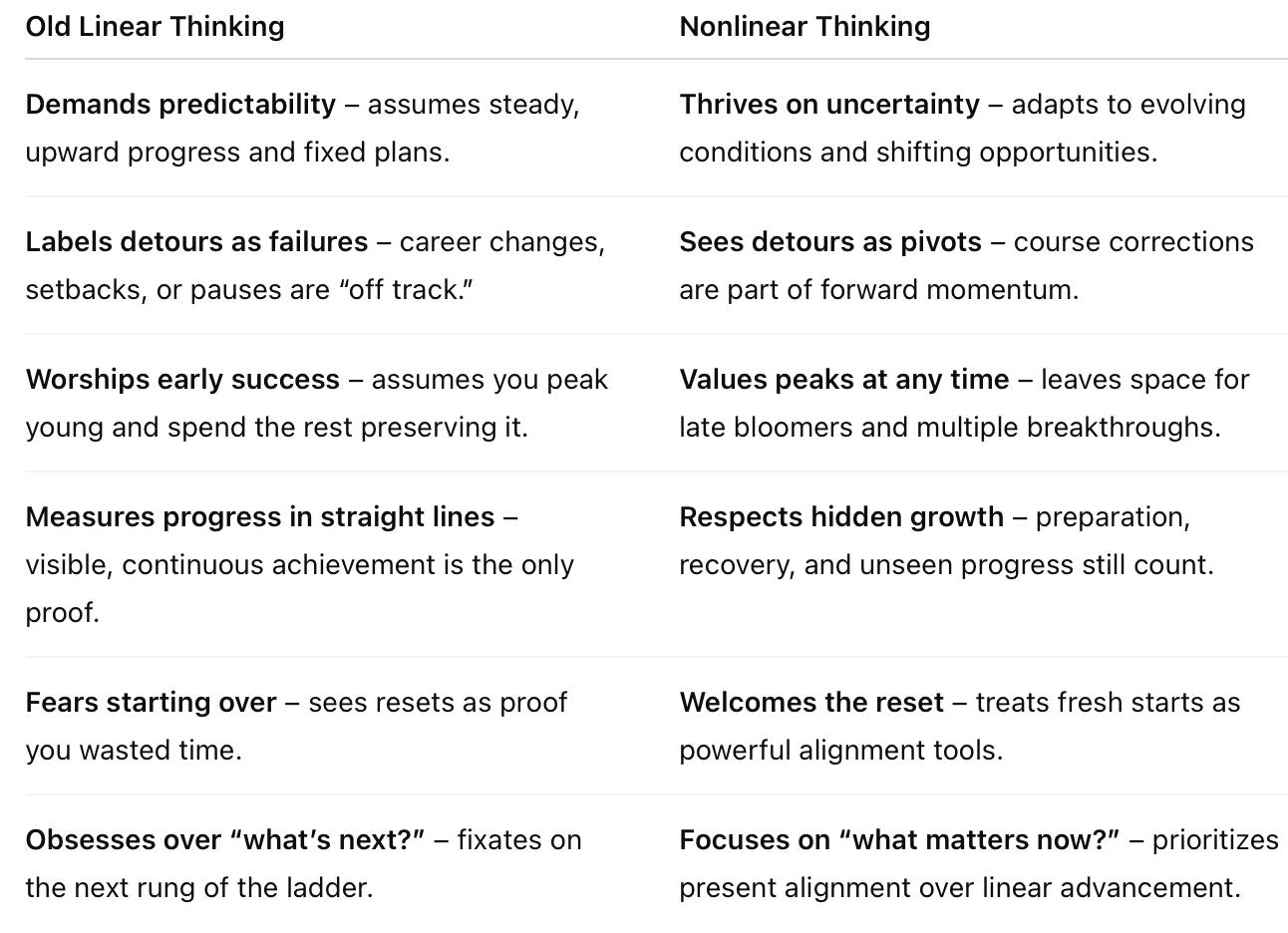P2: Nonlinearity - The Best Paths Are Never Straight
"The greatest skill of the 21st century is the ability to reinvent ourselves again, and again, and again." — Yuval Noah Harari
- The Problem: We've been conditioned to view life as a linear progression—school, career, milestones—as if any deviation is a failure. This rigid mindset, designed for a slower and more predictable world, leaves us feeling "behind" when life doesn't unfold according to plan.
- The Shift: Instead of a straight path, imagine life as an open landscape. A nonlinear perspective welcomes detours, pauses, and leaps as essential parts of growth. It prioritizes alignment, adaptability, and reinvention over sticking to a rigid timeline.
- The Payoff: By letting go of outdated expectations, you no longer feel confined to someone else's definition of success. Instead, you move in rhythm with life, discovering freedom, resilience, and surprising opportunities in the unexpected twists and turns.
Introduction
We were raised on a fairytale of linear progress.
Study hard. Get the degree. Land the job. Climb the ladder. Save for retirement. Collect your reward.
In this script, life is a sequence of tidy chapters—one flowing logically into the next. The rules are clear. The milestones are scheduled. Deviations are discouraged.
But here’s the problem: that script is fiction. It was designed for a world that no longer exists.
Today, people change careers five or six times. Relationships evolve. Industries collapse overnight. A global pandemic can flip your life upside down in a matter of weeks. You’re expected to reinvent yourself again and again—but you’re still being judged by the logic of a world where "settling down" was the goal.
And yet, despite overwhelming evidence that life is messy, we cling to the fantasy that our lives should make sense in hindsight. That each step should follow logically from the last. That detours are mistakes. That uncertainty is failure. That only the “straight path” is respectable.
This is the cultural illusion we need to unlearn.
Why Linear Thinking Holds Us Back
Linear thinking isn’t just outdated. It actively clashes with the realities of our rapidly changing world.
The "straight and narrow" mindset doesn’t bring clarity. Instead, it creates hidden tension:
- You feel “behind” when life doesn’t unfold as neatly as planned.
- You blame yourself when things don’t go as expected.
- You chase milestones that may not even align with your values.
We don’t just follow society's life scripts—we internalize them. So when life takes an unexpected turn, we don’t question the script.
Instead, we assume we’ve failed.
Here’s how linear thinking silently limits us in a nonlinear world:
1. We're Still Running Old Scripts in Our Heads
Even if we’ve outgrown the outdated roadmaps, their core assumptions often linger beneath the surface.
These inherited mental frameworks quietly shape how we evaluate ourselves—and keep us stuck in familiar patterns.
- Detours Aren't Failures – Losing your job, a business collapse, the end of a relationship, a major health scare, a stalled project, a life move that didn't work out, financial struggles, or unexpected setbacks caused by external factors don’t signify failure. They’re simply moments of adjustment. Growth is almost never a linear path.
- The Trap of Invisible Timelines – Society’s unspoken timelines, like “married by 30” or “financially secure by 40” create unnecessary stress. Even if your unique path is more fulfilling, linear metrics make you feel “off-track.”Your life is not a race!
- The Paralysis of Perfection – When every step is treated as make-or-break, decision-making becomes overwhelming. Linear thinking trains us to fear mistakes, stopping progress before it begins. Perfectionism kills creativity, growth, and momentum.
- Comparing Mismatched Journeys - Linear thinking pushes us to compare ourselves to others, treating life like a race. But in a nonlinear world, with diverse values and starting points and destinations, comparison becomes meaningless. Your path is your own!
2. We Assume a Fixed Identity
Linear thinking assumes you'll pick one role, one goal, or one identity early - and then stick with it forever.
But humans aren't desgined for that. Our motivations, goals, and passions evolve, our skills expand and contract, and our identities adapt.
- Career Identity Lock-In – Titles like “engineer,” “manager,” or “founder” can feel inescapable. Too often, we stay put because our role defines us. But you’re more than your job; it’s a single chapter, not your story.
- Overplanning in a Chaotic World - Rigid 10-year plans often fail because the world shifts too quickly. Success increasingly favors those who adapt, not those who cling to outdated roadmaps.
- Narrow Definitions of Identity - A linear mindset tells you to choose one thing to be. But life is multidimensional. You’re allowed to be a creative, a problem solver, a mentor, and a beginner all at once.
- Overlooking Lived Experience: Linear scripts overvalue traditional credentials while undervaluing the wisdom learned through life’s messier chapters, like failure, parenting, or starting over.
3. We're Mentally Misaligned With the World We Live In Today
Linear thinking might have worked in a more predictable past, but it’s ill-suited for today’s fast-changing terrain.
Adapting to uncertainty is now more valuable than following a fixed route.
- Reinvention as a Necessary Life Skill – Pivoting multiple times in life isn't a flaw, and don't let anyone tell you so. In today's nonlinear world, constant iteration and reinvention is not just about survival. It's becoming the norm, not the exception.
- Stifling Curiosity & Play – Linear progress prioritizes efficiency over exploration, leaving little room for curiosity or creative wandering. But serendipity often yields the most meaningful breakthroughs.
- Aging as Transformation, Not Decline – If life is a climb, aging feels like the descent. But what if later years were reframed as a new stage of creativity, freedom, or learning? Nonlinear thinking honors every stage of life as valuable.
- It Undervalues Flexibility, Mental Agility, and Resilience – The modern world doesn’t reward rigid planners; it celebrates fast learners. Emotional agility, adaptability, and the courage to pivot matter more than rigid adherence to a straight path.
So if the linear script no longer fits, what does? What does it actually mean to live a nonlinear life?
Why This Matters Now
In a nonlinear world, we don’t just need to create new habits—we need to rethink the way we see and approach the world around us.
When life becomes unpredictable, simply working harder or staying optimistic isn’t enough. What’s needed is something more grounded and transformational: a way to understand and navigate a world that no longer fits traditional patterns.
This is why nonlinearity matters—not just as an abstract philosophy but as a practical approach to living and working.
Because here’s the truth: the challenges we face aren’t just personal. They are systemic.
You can follow all the rules and still feel like you’re falling behind. You can redefine your path in meaningful ways, yet feel invisible because it doesn’t match conventional milestones. You can make bold changes in your career, identity, or priorities and still feel weighed down by societal expectations of “normality.”
Before rushing to adopt new strategies or routines, it’s worth stepping back for a moment. Taking a broader view.
Because if the roadmap you’re using is outdated or broken, discipline and hard work won’t stop you from feeling lost.
This section encourages that pause, offering a wide-angle perspective. It investigates why the idea that “The Best Paths Are Never Straight” is not only relevant but essential in today’s world.
1. The Old Scripts Don’t Fit a Fluid World
The traditional life roadmap — school, job, promotion, marriage, house, retirement — was designed for a world of stability and predictability. That world is gone.
Today, industries rise and fall in a decade. Technologies upend entire professions in months. Global events like pandemics or economic shocks can disrupt plans overnight.
Yet we’re still measured by metrics designed for a slower, linear world. Milestones like “married by 30” or “homeowner by 35” persist — even as housing markets collapse, career ladders flatten, and family structures diversify.
This mismatch between reality and expectation creates friction. It leads to shame, confusion, and unnecessary suffering.
What we need isn’t better performance inside the old model.
What we need is a new model.
2. AI and Automation Are Reshaping Work and Identity
We’re in the middle of a massive redefinition of what “work” even means. Roles that felt secure a decade ago are now outsourced, automated, or AI-enhanced. The half-life of a professional skill is shrinking fast.
In this environment, it’s no longer the specialists who win — it’s the adaptors.
The person who can reinvent themselves. The one who knows how to pivot, retool, or shift domains. The one who doesn’t cling to a fixed title, but builds a flexible identity that they can evolve over time.
But without a nonlinear mindset, this feels terrifying.
We interpret career change as instability. We frame reinvention as failure.
When in fact, both are signs of strength.
If you still believe success means choosing one thing and climbing upward forever, the 21st-century world of work will break that belief again and again. Better to let go of it now — on your own terms.
3. The 100-Year Life Is Already Here
The average lifespan is stretching toward 100 years. But our life model hasn’t stretched with it.
The traditional three-stage model — learn, earn, retire — doesn’t fit a life that spans multiple decades of change, learning, and reinvention. That model was built for a 40-year career and a 10-year retirement. It wasn’t designed to support multiple careers, pauses, second acts, and creative revivals at 60 or 75.
But that’s the reality we’re facing. And it’s not a burden — it’s a huge opportunity.
A nonlinear model honors the idea that your best work might not happen in your 30s. That your purpose may evolve across life chapters. That a second or third reinvention isn’t a deviation — it’s the design.
If we’re going to live longer, we need to live wider. The linear story simply doesn’t stretch far enough.
4. Comparison Culture Is Fueling Mental Burnout
Social media has compressed life into highlight reels. You see people’s wins, not their mess. Their outcomes, not their process.
The result? You internalize the myth of effortless, linear success.
Everyone else looks “on track.” You feel like you’re drifting.
But here’s the truth: most lives are messy, adaptive, and full of resets. We just don’t see those parts.
Without a nonlinear lens, we start measuring our lives against invisible scripts that aren’t even real.
We chase timelines that don’t match our values.
We abandon meaningful paths because they don’t look tidy.
This isn’t just a personal confidence issue — it’s a systems problem. We’ve built an entire digital culture on distorted stories of progress.
Nonlinear thinking interrupts that distortion. It reminds us that zigzags aren’t mistakes — they’re how most lives actually work.
5. Crisis Isn’t the Exception Anymore — It’s the Environment
Let’s be honest: the idea that life unfolds smoothly is a comforting lie.
Whether it’s a pandemic, a layoff, a divorce, a chronic illness, or just the slow friction of misalignment — disruptions are no longer rare events. They’re woven into the fabric of modern life.
And yet, we’re still trained to see these moments as breakdowns.
We assume we’ve failed. That we’re “off track.”
When in fact, there is no track.
Linear thinking leaves us unprepared for what real life demands: agility, reinvention, emotional resilience, and courage in the face of uncertainty.
Nonlinear thinking doesn’t guarantee ease. But it does offer a more honest — and powerful — frame for living inside chaos without losing yourself.
If you still believe success means choosing one thing and climbing upward forever, the 21st-century world of work will break that belief again and again.
This principle matters now because it names the disconnect — and offers a way through it.
It reminds us that we’re not broken for not fitting the old script.
That detours aren’t errors. That identity isn’t fixed. That reinvention isn’t failure.
It offers clarity — not by simplifying life, but by giving us tools that actually match its complexity.
Nonlinear thinking doesn’t just describe the world as it is — it prepares you to live well inside it.
Why the Old Model Falls Short
The traditional three-stage life of education → career → retirement was designed for a time when life was shorter and more predictable.
It no longer aligns with today’s fast-changing landscape, as factors like increased lifespans, technological advancements, and economic shifts highlight its limitations.
1. People Are Living Longer Than Ever
Then – Back when life expectancy was 60–70 years, it made sense to spend your youth in education, then work for 30–40 years, and retire for 5–10 years.
Now – With many living to 90 or 100, retirement could span 25–35 years. It’s impractical to rely on savings from a single career to fund such a long period, and staying inactive for decades is neither rewarding nor realistic.
2. Careers Are Unpredictable and Nonlinear
Then – Most people entered a profession in their 20s, stayed within one industry, and retired with a pension.
Now – Rapid industry disruptions, disappearing job categories, and frequent career shifts are the new norm. Long-term stability with one company or role is rare, and economic uncertainty often forces unexpected changes.
3. Skills Become Obsolete Faster
Then – A degree or training early in one’s career could sustain them for decades.
Now – Automation, AI, and evolving business models can render skills outdated in less than a decade. Lifelong learning has become a necessity, but the old model assumes learning only happens in the first stage of life.
4. Retirement as We Knew It Is Fading Away
Then – Company pensions and lower living costs made stopping work entirely at 60–65 feasible.
Now – Rising costs, reduced pensions, and less reliable investment returns make it financially difficult to stop working completely. Many are redefining retirement to include part-time work or phased transitions.
5. Longer Lives Require Identity Reinventions
Then – A single professional identity could last a lifetime.
Now – Longer lifespans allow (and often require) people to reinvent themselves multiple times. The old model doesn’t account for these many personal and professional “chapters.”
6. Better Health Extends Post-Career Vitality
Then – Retirement was brief, partly due to earlier physical decline.
Now – Many remain healthy and active well into their 70s and beyond, making prolonged inactivity wasteful and unfulfilling.
7. The Psychological Disconnect
Then – Following a predictable script brought stability and reward.
Now – A rigid path of one lifelong career followed by a long wind-down feels restrictive. This can lead to boredom, loss of purpose, and even mental decline.
The Bottom Line
The three-stage life was built for a shorter, more stable, and predictable world.
To thrive in today’s reality, we need an adaptive multi-stage model that integrates lifelong learning, career shifts, sabbaticals, portfolio careers, and opportunities for reinvention across an extended lifespan.
How Nonlinear Life Took Shape
For much of history, life was anything but predictable. Work, learning, and family life flowed together in cycles defined by natural rhythms, community needs, and survival.
Change was a constant, but it unfolded gradually, locally, and visibly.
Then came the Industrial Revolution, and everything shifted. Factories and offices demanded adherence to rigid schedules. Careers grew increasingly specialized. Education was packed into childhood and youth, work consumed the adult years, and rest was deferred to old age.
Stability and routine became essential survival strategies, shaping a new kind of order in life.
After World War II, this "linear life" model became the cultural norm.
Prosperity, corporate jobs, homeownership, and pensions created an ideal path that led from education to career to retirement. In much of the Western world, this formula was promoted as the ultimate sign of success and security.
But by the late 20th century, this linearity began to fray. Advances in globalization and automation destabilized industries at an unprecedented speed, while people began living longer lives.
Jobs that once seemed secure disappeared or transformed in mere years. Skills became outdated faster than ever. The idea of sticking to one fixed path for life started to feel restrictive rather than liberating.
Fast forward to the 21st century, where change no longer inches forward but accelerates exponentially.
Entire industries now rise and fall in just a matter of years. Technology continuously redefines job roles in months rather than decades. Meanwhile, economic, environmental, and geopolitical crises aren’t passing disruptions; they are ongoing realities.
The life we once defined through linear stages doesn’t align with this new environment. Nonlinear paths, where career changes, lifelong learning, and adaptation are the norm, now reflect the way we live and work.
Thinking in straight lines made sense in an era of predictability. That era has ended, and with it, the idea that life must follow a single rigid template.
What This Principle Actually Means
Trust the Compass, Not the Map!
As explained in the Longevity Principle, a compass is more valuable than a clock when life is measured in decades instead of deadlines
Here, we take it a step further—a compass is also more dependable than a map, especially in a world where change is constant and unpredictable.
Nonlinear living doesn’t mean wandering without purpose. It means understanding that the path ahead won’t mirror the one behind you.
That’s not a problem. It’s the essence of true growth.
This idea challenges rigid, pre-planned life scripts. You don’t need every milestone mapped out to move forward. What matters most is staying focused on your core values and being flexible enough to adapt when life inevitably shifts directions.
Linear thinkers ask, “What’s the exact plan?”
Nonlinear thinkers ask, “Which direction feels most aligned, and what opportunities might it open next?”
When living a 100-year life, you won’t craft a tidy, one-story narrative. You’ll write many. Some will loop back, others may hit a dead end.
There will be rewrites, resets, and unexpected twists that will come faster than you can predict.
And here's the deeper truth: Life has never followed a perfectly straight path. The old, idealized narrative made it seem that way, but the truth is different.
Careers take unexpected turns, relationships change, priorities realign, and personal reinvention happens repeatedly. The only certainty is that the journey will always surprise you.
That's not failure. In a nonlinear world, that's a sign of progress.
This principle encourages you to:
- Release the limiting “shoulds” and explore new “possibilities.”
- See pivots as steps forward, not indications of being lost.
- Prioritize alignment over rigid timelines or sequences.
Life rarely follows a linear path anymore. The sooner you accept this reality, the sooner you’ll confidently chart your course—with your compass guiding the way.
Key takeaway: In a nonlinear world, the compass holds greater value than the map.
The Reality You Can't Ignore
The unavoidable truth of modern life is this: stability is no longer the default state. It’s a tough reality to accept, but one that can’t be ignored.
Reinvention will become a regular part of life, often arriving unexpectedly and outside of your control.
Here’s what that means in practice:
1. Change Is Constant and Unpredictable
The forces altering your career, finances, health, and identity—like technology, globalization, shifting geopolitics, climate change, and interconnectivity—aren’t slowing down.
When everything is so interconnected, even small events can create massive ripple effects. Entire industries, jobs, or skills can become irrelevant in a matter of months.
Nonlinearity isn’t a temporary disruption to endure; it’s the new way the world operates.
2. Your Old Strategies Won’t Always Work
The education, connections, and tactics that helped you succeed in the past may no longer deliver results in the future.
Relying on a single career, employer, or skill set can leave you vulnerable.
Clinging too tightly to an identity like “this is who I’ve always been” makes it harder to adapt when reinvention is necessary.
3. Delaying Action Carries Greater Risks
The longer you wait to adapt, the harder it becomes and the fewer options you’ll have when change inevitably arrives.
Small, proactive steps are far more effective than making sudden, drastic adjustments at the last minute.
What feels like your comfort zone today could soon turn into a trap.
4. Living Longer Adds More Uncertainty
While living to 90 or 100 offers more opportunities to enjoy life, it also means experiencing more economic cycles, health challenges, relationship changes, and technological disruptions.
One major reinvention isn’t enough anymore; extended lifespans require multiple reinventions with new skills, income sources, and evolving identities at every stage.
The Bottom Line
There’s no guaranteed smooth path through life. Ignoring this reality only increases the likelihood of unexpected setbacks.
Those who thrive in a nonlinear world make adaptability their priority. They expand their options at every turn, view reinvention as a fundamental skill, and understand that it’s not a detour. Reinvention is the path forward.
The Hidden Truth No One Tells You
In a nonlinear world, the ability to quit, adapt, or start anew isn’t a sign of failure—it’s a skill for survival.
For too long, people have held on to the outdated belief that changing direction equates to failure.
The traditional, three-stage life praised sticking to a plan, climbing a single ladder, and seeing everything through to the end. But in today’s fast-changing landscape, the rules are different:
- Quitting can be your smartest decision – Staying too long in a struggling industry, an unsustainable business, or an unhealthy role saps your energy, resources, and future opportunities. Recognizing when to move on isn’t about giving up—it’s about reclaiming your energy to focus on what’s next.
- Being persistent without adapting is a trap – While grit was celebrated in the past, today it can backfire if it keeps you stuck on an outdated track. Without the ability to adapt, your relevance and opportunities may slip away in a constantly evolving world.
- Security lies in portability, not permanence – In the past, stability came from staying in one place. Now, your ability to thrive depends on your transferable skills, broad network, and adaptability to take your expertise anywhere.
- Every phase of life is a prototype – Careers, businesses, and personal identities are works in progress. The goal isn’t to complete them but to continuously test, refine, and align them with the world as it evolves.
Here’s the uncomfortable truth:
The people who succeed in a 90–100-year life won’t be the ones fixated on following their original plan. They’ll be the ones ready to pivot or walk away the moment that plan stops serving their growth and future.
If you ignore this truth and continue to follow outdated linear rules, the consequences can build up over time, often going unnoticed until they become too significant to address.
The Costs of Getting This Wrong
Living a nonlinear life while following outdated linear rules comes at a steep price. These costs can accumulate over time, often unnoticed until it’s too late.
Here’s how it manifests:
1. Missed Opportunities – Sticking with a rigid path for too long means watching prime opportunities slip by while you wait for the “right time.” Nonlinear life thrives on timing, and making delayed changes could leave you arriving just as the best rewards are gone.
2. Skill Obsolescence – If you concentrate all your learning early in life and fail to adapt or update, your skills can quickly lose value. By the time you realize your knowledge is outdated, you’ll be competing with those who have consistently evolved.
3. Trapped Identity – Defining yourself too narrowly (“I’m a lawyer,” “I’m a manager,” “I’m an entrepreneur”) can make other possibilities invisible or too intimidating to explore. This often leads to holding onto roles or paths that no longer serve you, simply because the alternative feels riskier.
4. Financial Vulnerability – Traditional models assume a linear career with one income and secure retirement savings. But today, economic shocks, like layoffs or industry disruptions, can wipe out primary incomes. Without diverse income streams or adaptable skills, recovery can be slow and financially draining.
5. Burnout – Pushing yourself to stick to a poorly matched path depletes your motivation and resilience. Burnout becomes especially risky in a nonlinear world, as it can leave you too drained to capitalize on future opportunities when they arise.
6. Loss of Options – Every year spent on a declining path narrows your choices. Networks weaken, new skills pass you by, and industries evolve until pivoting becomes reactive to a crisis rather than proactive on your terms.
And here’s the challenging part:
One of the biggest misconceptions in a nonlinear life is expecting progress to unfold steadily.
Sometimes, it takes months or years of effort before a sudden breakthrough that seems like “overnight success.”
Without understanding this pattern, people often quit just before reaching the tipping point. Both abandoning a path too early and sticking with it too long carry heavy costs in a nonlinear world.
What This Principle Is NOT
Choosing a nonlinear life path doesn't mean discarding structure or succumbing to chaos.
It’s not about aimlessly drifting; it’s about taking control and learning to steer.
It’s not rejecting progress but rather reshaping how progress looks and feels.
Here’s what nonlinear living doesn’t represent:
❌ It's NOT living without discipline – Nonlinear living isn’t about scrapping structure or simply “going with the flow.” Instead, it’s about building adaptable habits and frameworks that stay strong even when the unexpected happens.
❌ It's NOT about being in constant crisis mode – Reinvention doesn’t have to mean burning everything down. You don’t need emotional upheaval to grow. Real change thrives in quiet, deliberate evolution.
❌ It's NOT about avoiding tough decisions – Adaptability doesn’t mean running from difficult choices. Quite the opposite, it requires making more decisions with courage, speed, and integrity.
❌ It's NOT saying No to Ambition – Flexibility doesn’t mean giving up on goals. Instead, it’s about creating a new approach to achieving them. Within a nonlinear life, ambition is redefined by adaptability and alignment, not by a rigid pursuit of fixed milestones.
❌ It's NOT Effortless Freedom – A nonlinear life still demands consistent action. Sometimes it can be harder than a predefined path because you're creating as you go. But with dedication, the freedom you gain is well worth the effort.
Understanding what nonlinear living isn’t clears the way to appreciate what it is.
The true transformation begins when you stop fearing unpredictability and begin to see it as something you can shape, control, and leverage to your advantage.
The Real Mindset Shift
Linear thinking expects predictability, steady progress, and one clear “right track.” It treats detours as mistakes, resets as setbacks, and late breakthroughs as anomalies.
The nonlinear mindset flips that:
- Change is not an interruption — it’s the default.
- Detours are not failures — they’re the process.
- There is no fixed track — only the one that fits you now.
This shift means:
- You measure progress by alignment, not by sequence.
- You treat pivots and pauses as part of your forward motion.
- You hold plans lightly, so they can flex with reality.
When you stop forcing life to match a rigid script, you release the pressure to “stay on track” and focus instead on what makes sense now, given everything you’ve learned.
The nonlinear mindset doesn’t promise clarity at every turn. What it offers is something better: the ability to keep moving — with purpose, without apology — even when the road ahead bends, forks, or disappears entirely.
Mindset Shift at a Glance

Summary: Nature Hates Straight Lines
Nature doesn't do straight lines – And Neither Should You
Here’s the truth about every “perfectly planned” life or “overnight success” story you’ve heard: they’re curated. The behind-the-scenes reality includes missteps, unexpected turns, closed doors, and surprise wins that rarely make it into the spotlight.
We’ve been taught to see life as a straight and predictable path from Point A to Point B. But the truth? Life’s more like a zigzag—from Point A to Q, back to C, and onward to places you never expected. Trying to follow a rigid, linear path only fuels the false belief that you’re “behind,” even when you’re exactly where you’re meant to be.
Living a nonlinear life means progress won’t always be obvious, your path won’t always be smooth, and your goals may evolve over time. That’s not a flaw in the system; that is the system.
The goal isn’t about staying “on track.” It’s about cultivating the resilience, adaptability, and self-confidence to continue the journey—even when the road twists, divides, or seems to vanish altogether.
Don’t hold onto old maps. Grab a compass instead. The terrain will keep shifting, but your ability to chart your course—with trust in yourself—is what turns uncertainty into opportunity.
TL;DR
Lose the Map. Use the Compass.
Nonlinear living isn’t aimless; it’s dynamic navigation. It’s about knowing that when the path changes, you can pivot with it. And in doing so, you’ll achieve more than any rigid, straight-line path could promise.
Additional Resources:
FAQ About This Principle
Curious? Tap a question below to explore more.
▶ Isn’t a nonlinear life just an excuse for being unorganized or unfocused?
A: Not at all. A nonlinear life still demands purpose and clarity, just in a different form. You don’t need every step outlined to be intentional. Instead, it takes greater self-discipline to build resilience, self-awareness, and an internal compass when external milestones aren’t dictating your direction.
▶ Doesn’t success still require a plan?
A: Absolutely. But think of your plan as a flexible guide rather than a rigid blueprint. It’s less like a train schedule and more like a sailing chart. You need a sense of direction but not step-by-step instructions. Linear thinkers often wait for the perfect conditions, whereas nonlinear thinkers adapt to the winds while staying on course.
▶ How do I measure progress if the path isn’t straight?
A: The way you define progress has to change. Instead of asking, “Am I where I’m supposed to be?” ask, “Am I moving toward the person I want to become?” You’re making progress when you feel more aligned with your values, more energized, and more truthful—even if it doesn’t look like conventional success on paper yet.
▶ What if I’ve taken so many side paths that I don’t know where I’m headed anymore?
A: That’s where things get interesting. When the path feels blurry, you’ve reached a space of potential. Stop fixating on a destination, and start paying attention to the sparks, nudges, and signals around you. Nonlinear journeys thrive on curiosity, not certainty.
▶ Why does everyone else’s life look more together than mine?
A: Because linear paths are easier to showcase publicly. But behind the scenes, everyone deals with pivots, restarts, and uncertainties. The difference isn’t the reality of their path; it’s whether they’re honest about it.
▶ Isn’t this kind of thinking just for creatives or people with no responsibilities?
A: No. A nonlinear approach doesn’t mean chaos. It means adaptability. Whether you’re raising kids, running a company, or managing day-to-day responsibilities, nonlinear thinking helps you adjust to life’s complexities without burning out. It’s not just creative or optional; it’s a strategy for thriving.
▶ When will I finally feel “on track”?
A: Stop chasing that question. Life isn’t a set of rails you’re supposed to follow. Instead, ask, “Am I moving? Am I aligned with what matters? Am I open to what’s emerging?” Those are the markers of a fulfilling path—even if it doesn’t look linear from the outside.
Advanced Reflections
This section is currently in development.
We're currently gathering thoughtful questions to provide clear and helpful answers that expand on the ideas shared above.
We aim to aim to launch this section shortly.
Please check back soon!
Toolkit
This section is currently in development.
We're currently gathering thoughtful questions to provide clear and helpful answers that expand on the ideas shared above.
We aim to aim to launch this section shortly.
Please check back soon!
Next Steps:
- ← Back to All 21 Principles
Browse the full library of Agilism’s foundational ideas for navigating a nonlinear world. - Explore the Dimensions →Lifestyle Design, Emotional Flexibility, Mental Models, Atomic Goal Setting (Coming soon: clickable cards for each gateway).
- Return to the Full Agilism Overview →
A primer on what it is, where it came from, and why it matters. - Download the “21 Principles” eBook →
Subscribe to our newsletter to get your copy and stay updated with fresh insights as the framework evolves.

Previous

Next
Explore the Other Agilism Dimensions
Browse other Dimensions to expand your Agilism journey






